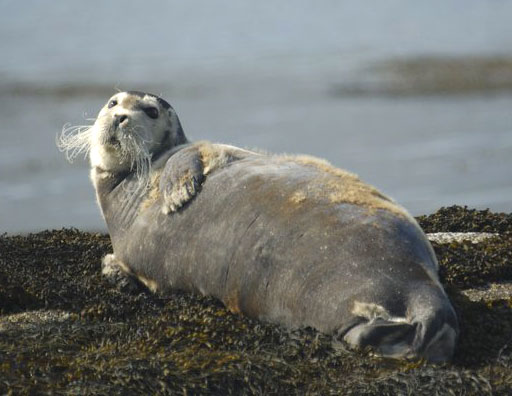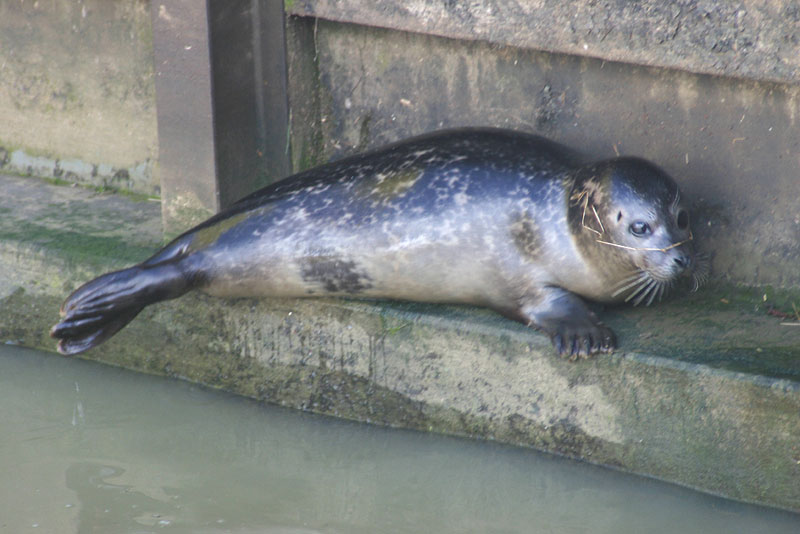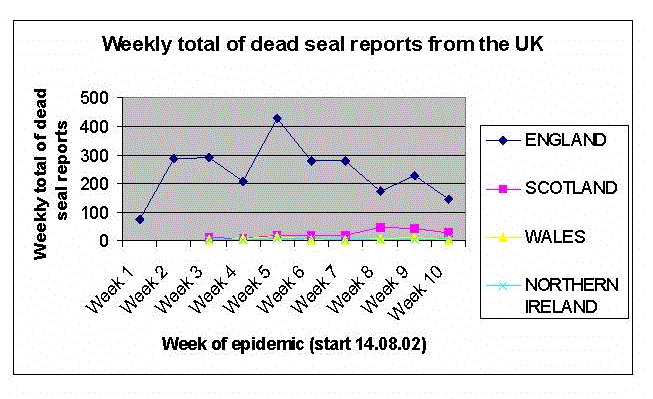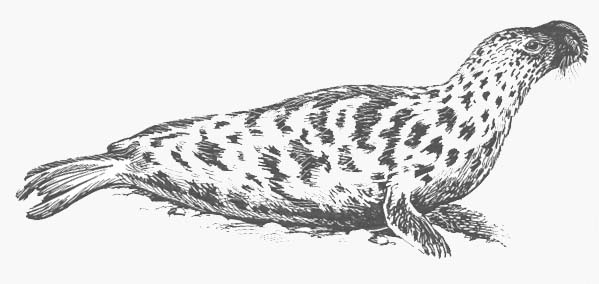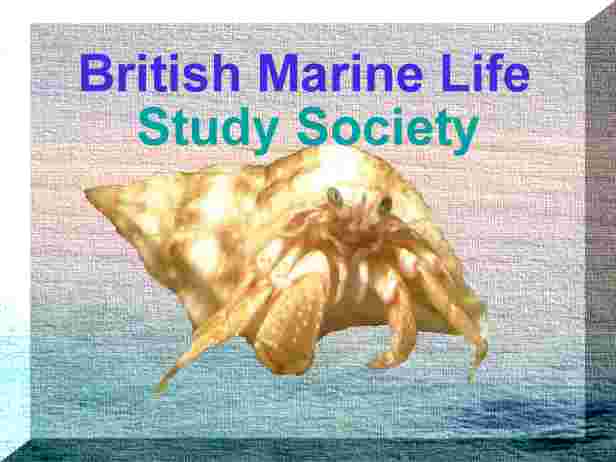 |
| Homepage |
| Index |
| News |
| Main Links |
 |
| Sea Mammals |
|
|
News
11 - 14 July 2008
There has been a Grey Seal in the River Great Ouse in Bedfordshire since
Friday 11 July 2008 first spotted by fishermen at Kempston. It was seen heading back towards the sea at Cardington Lock at 10:00 am on 14 July 2008. This is the first Grey Seal recorded in Bedfordshire (the first seal of any sort in Bedfordshire).Report by Richard LawrenceImage 1
Image 23 March - 26 May 2008 onwards
A Bearded Seal, Erignathus barbatus, was spotted at Loch na Keal on the Isle of Mull, a large island in the Inner Hebrides, western Scotland. The healthy seal had hauled itself up on to some dry rocks when it was first seen. Subsequently, it has been unpredictable in its movements. The Bearded Seal was first seen by David Woodhouse (Mull Wildlife Expeditions) on 3 March 2008.
19 March 2008A Common Seal, Phoca vitulina, swam up the River Medway in Kent as far as Allington lock which is several miles upstream of the Medway estuary mouth and is at the tidal limit. My understanding is that the seal was in the area for several days. I also understand that now it has gone further upstream to East Farleigh, as a result I believe the RSPCA were called but have left it in situ as it was not in any distress.
Report & Photograph by Tony Thorogood (Photony)
February 2008
Up until now it has been assumed that the Common Seals, Phoca vitulina, that we see along the Sussex coast are either from the Wash area or from the Chichester colony. Grey Seals, Halichoerus grypus, have been assumed to come from either further west or east. However a Common Seal tagged in 2007 by the University of Rochelle crossed the English Channel and swam east along the Sussex coast.
3 January 2008
A Grey Seal, Halichoerus grypus, was washed up dead on the shore at Sheringham in Norfolk with a large 35 cm wound reminiscent of a predator attack. The jury is out on the cause of the wound which could be as a result of fishing activity. Or it could be a deliberate attempt to mislead the Sun newspaper?Report and Photograph on the Sun Newspaper Web PageDiscussion on the Marine Wildlife of the NE Atlantic Yahoo Group
More DiscussionThe previous week in Kent we had a dead seal turn up with large wounds on it. They were circular and about 50 mm in diameter.
19 November 2007
A Bearded Seal, Erignathus barbatus, was seen at Chanonry Point area on the coast of the Moray Firth near Inverness, Scotland, having been there for about two weeks.
Link to a PhotographReport by Farnboro John on the Bird ForumBMLSS Bearded Seal page21 October 2006
Grey Seal, Halichoerus grypus, pup on the Farne Islands
Photograph by Kevin BoothroydThe Farne Islands (National Trust) are home to around four thousand Grey Seals, and the birthplace of over one thousand seal pups in October and November each year. At low tide the seals will haul out on to the rocks.
24 February 2006
Marine Life of Sussex News
An oiled and very old and worn Grey Seal, Halichoerus grypus, was washed up on the rocky shore at Cuckmere Haven (near the Seven Sisters), East Sussex. It was at the end of its life span and was euthanised.
NB: Grey Seals are almost unknown off Sussex, where the Common Seal is only occasionally seen.15 November 2005
A Common Seal, Phoca vitulina, swam up the tidal area of the River Ouse in East Sussex up a narrow winding river for three miles to Southease (south of Rodmell) which is a tidal stretch. (The Ouse is tidal as far as Barcombe Mills, north of Lewes.) Common Seals occur of the coast of Sussex but they are only occasionals and not regularly seen off East Sussex, although there is a small rookery in Chichester Harbour in West Sussex, and they are seen around Selsey.
Marine Life of Sussex15 October 2005
I spotted a seal in the River Thames near Kew Gardens in west London. It was probably a Common Seal, Phoca vitulina. This part of the river is tidal up to Teddington.Report by Richard Clayton
25 August 2005
A seal was trapped in Sharpness tidal basin after the morning tide, and when the basin was levelled that evening for two ships to leave, it managed to escape up the dock. The following morning, the seal was sighted in the canal between Purton and Shepherds Patch, but luckily it found its way back to Sharpness where the lock gate men locked it back out into the river. The seal species was not identified.Report by John Putley
(from the Gloucester & Sharpness Canal Newsletter, August 2005)
on the Marine Wildlife of the North-east Atlantic Ocean Group
30 April 2005 to 3 May 2005
A Bearded Seal, Erignathus barbatus, is seen at Easter Quarff (north of Cunningsburgh), Mainland, Shetland Isles.Bearded Seal
Photograph by John Coutts
Report on Shetlands Sea Mammal Sightings and Photographs
1 April 2005 for 2-3 weeks
A Bearded Seal, Erignathus barbatus, was resident in the Ouse, Finstown, Orkney for 2-3 weeks from the beginning of April. It came as a great surprise to me when I was informed by a dog walker on the Ouse that she had come across an unusual seal asleep on the shoreline. On investigation I identified the seal as a juvenile female Bearded Seal. Bearded Seals are normally found all along the European, Asiatic and North American coasts of the Arctic Ocean. Its food consists entirely of bottom-living animals including shrimps, crabs, clams, whelks and bottom fish such as flounder. It is a very unusual seal to be found in the waters of Orkney.
BMLSS Bearded Seal page
Report by Ross Flett (Orkney Seal Rescue)
on the Marine Wildlife of the North-east Atlantic Ocean Group
24 June 2004
When Mike Rafter was at Inchmery Quay (at the mouth of the Beaulieu River), Hampshire, he saw a large seal resting on a floating landing stage and wondered if it had been driven inshore by yesterday's storms. Val Lowings responded to this query, saying .. 'A Grey Seal, Halichoerus grypus, has been using the landing stage on the Beaulieu River to rest on for quite a few months now. It is very tame and does not move when people/boats approach. The RSPCA seal expert has had a look at it and it seems quite healthy. I believe it is tagged, but not with a UK tag, so it is thought to have come from a 'sanctuary' in Europe'.
13 June 2004
A young female Hooded Seal, Cystophora cristata, was discovered on Dunnet Beach, Caithness, Scotland. It was treated by British Divers Marine Life Rescue who plan to return the seal to the Orkney Isles nearer its natural habitat around Greenland and the Denmark Strait (between Iceland and Greenland).Report by Alistair Jack of British Divers Marine Life RescueBritish Marine Life Rescue News Page (with the Full Report)31 March - 2 April 2004
Another Common Seal, Phoca vitulina, ventures up the River Thames to the densely populated urban area at Lambeth and gets covering in mud, prompting a rescue mission by British Divers Marine Life Rescue.
British Divers Marine Life Rescue News Page (with the Full Report)26 March 2004
A Hooded Seal, Cystophora cristata, was discovered on St. Ives beach, Cornwall, by British Divers Marine Life Rescue. The Hooded Seal is an Arctic species and even discoveries off the coast of Scotland, including the Orkney and Shetland Isles are rare. It moults around Greenland and the Denmark Strait (between Iceland and Greenland).
British Divers Marine Life Rescue News Page (with the Full Report)
Hooded Seal 2001 (SW Wales)17 February 2004
A seal was spotted in the River Thames, London, by Richmond Bridge. It was about 120 cm in length. It was most likely a Common Seal, Phoca vitulina.Report by Phil Stubbs
20 October 2003
A seal caused a bit of flutter when it was spotted a long way up the tidal River Thames, swimming eastwards towards the sea between Waterloo Bridge and Blackfriars Bridge in a busy part of the city of London. This is less than a mile from the House of Parliament, Westminster.Report by Lloyd Goodman
27 September 2003
An outlandish and completely unexpected addition to the Portland Island (Dorset) mammal list came today in the form of a Harp Seal, Pagophilus groenlandicus, that was found hauled out on rocks along the East Cliffs at the Bill during the afternoon; it remained there for three hours before being flushed off by the incoming tide.
Photograph
The Harp Seal is an Arctic species that is hunted (cf. culled) in the frozen north of Canada.Report by Martin Cade via John Young via UK CetnetReport on Portland Wildlife News
ORCA (Organisation Cetacea) Report with previous sightings20 September 2003
When walking around Thorney Island, West Sussex, the number of Common Seals, Phoca vitulina, was 14, one more than has been previously recorded in Chichester HarbourReport by Barry Collins on Ralph Hollin's Nature Pages
Phocine Distemper Virus (PDV)17 December 2002
Between 11 December and 17 December there have been 47 dead seals reported around the UK bringing the total to 3682 since the beginning of the outbreak. The English deaths were down to 16 in the last week and are falling in Scottish seas after a sharp rise to 133 dead carcasses in the week ending 4 December 2002.
It is the total number of dead seals reported, irrespective of what they died of and this recent rise of mortality in Scottish seals has probably got more to do with the Grey Seal pupping period than any extra spread of the virus.
Weekly Graph (epidemic started 14 August 2002)
PDV Update
Status Report 1927 November 2002
Between 20 November and 26 November there have been 77 dead seals reported around the UK bringing the total to 3387 since the beginning of the virus outbreak.
PDV Update
Status Report 16
24 October 2002
Between 16 October and 22 October there have been 195 dead seals reported around the UK bringing the total to 2845 since the beginning of the Phocine Distemper Virus outbreak. 2451 of the seals have been found on the English coasts, with all but 24 of the above total discovered dead on the east coast. Confirmed cases are mostly Common Seals, Phoca vitulina, but also a few Grey Seals, Halichoerus grypus.
Sea Mammal Research Unit
Status Report 11 (with further details)11 September 2002
Between the 4 September and 10 September, 209 dead Common Seals, Phoca vitulina, were reported around the UK bringing the total to 1005 since the beginning of the Phocine Distemper Virus outbreak. 890 of these were from around the coast of England, predominantly from the Norfolk coast with smaller numbers reported from Suffolk, Lincolnshire, Northumbria and the East Riding of Yorkshire.Report by the Sea Mammal Research UnitSea Mammal Research Unit
Phocine Distemper Virus among European Seals 200213 August 2002
Tests on dead Common Seals, Phoca vitulina, found on carcasses from the coast of Lincolnshire and Norfolk have confirmed they died from the Phocine Distemper Virus. The British outbreak was confirmed by the RSPCA after five dead seals, including three pups, were found around the Wash.
News Story (Independent)22 June 2002
The Phocine Distemper Virus has been identified as the cause of a new increased total of 461 Common Seals, Phoca vitulina, carcasses tested in Denmark, with a further 150 in Sweden and dead seals also recovered on the shores of the Netherlands.
Ananova News ReportAny dead seals should be reported to the marine mammals stranding telephone line maintained by the Natural History Museum on 0207 942 5155 (24 hr answerphone).
Seal distemper (PDV) helpline number 08712 447999
> 10 June 2002
The bodies of more than 310 Common Seals, Phoca vitulina, have been washed up on the Danish and Swedish coasts, raising fears of an epidemic of the highly contagious and usually fatal Phocine Distemper Virus. The origin of the outbreak on the Kattegat and Skagerrak coast of Denmark and south Sweden prior to the breeding season is the same place as the 1988 epidemic which quickly spread to the east coast of England and killed about 2000 seals in the Wash (60% of the population). The first test was after high mortalities on the breeding seal population on the Danish island of Anholt (between Denmark and Sweden)The virus causes pregnant seals to abort their pups, pneumonia and nervous system abnormalities including convulsions.
Orange Seals (an explanation)
Grey Seal
Halichoerus grypus
Shetlands
Seal Page
This is an excellent page
and an essential site to visit for anybody interested in the two species
of resident British seals and records of vagrant seal visitors around the
Shetland Isles.
Seal
Pup Rescue
20% of Grey Seal pups on
the Scilly Isles die in the first few weeks.
(BBC
2 Natural World)
including the Pinniped News
United
Kingdom's Conservation of Seals Act 1970
Seals and Sealions (Jaap's Marine Pages)
Marine Mammals of the English Channel Smart Group
Zoonosis:
Marine Mammals to Humans
Habitat Protection for Scottish Seals
1 August
1999
The Scottish Wildlife Trust
paid tribute to the mystery benefactor whose cash gift enabled them to
buy the 56-hectare uninhabited island of Linga
Holm, in the Orkney Islands, Scotland, as a sanctuary for Grey Seals,
Halichoerus
grypus. Linga Holm is the world's third largest island-based breeding
colony of Grey seals with 2,300 pups having been counted there in 1997.
Scottish Wildlife Trust
at EMail: scottishwt@cix.compulink.co.uk
3 September
Area of Scottish isle to be reconsidered for protection - The Scottish Executive confirmed that the South East Islay Skerries on the Scottish island of Islay are to be re-considered as a proposed Special Area of Conservation (SAC) for Harbour Seals, Phoca vitulina vitulina, under the European Community's Habitats Directive. The decision comes after a petition was presented in the legal courts by the owners of an Islay seal sanctuary against the Scottish Executive for its decision to drop the site from its list of proposed SACs. The seal sanctuary is based at the proposed SAC site and releases its seals into the site. (see immediately below)
March
1999
A
marine Special Area of Conservation (SAC) for Harbour
Seals, Phoca vitulina vitulina, has been proposed
under the EC Habitats Directive for an area around the island of Sanday
in the Scottish Orkney Islands. Scottish Natural Heritage (SNH) has begun
a public consultation exercise on the proposed site.
For
more information, contact Ross Flett,
Orkney Seal Rescue, at
EMail:
SelkieSave@aol.com or Tel: +44-(0)1856-831463.
SNH
also announced that it has deferred notification of the South East
Islay Skerries, an important area for the Harbour Seal, as a Site of Special
Scientific Interest (SSSI). SSSI designation is necessary to underpin designation
as an SAC, for which the area has been proposed by the government as a
candidate site. Although both the U.K. Sea Mammal Research Unit and the
Advisory Committee on SSSIs specialist adviser supported SNH's view that
the site met the requirements for designation, the decision to defer notification
came after the objection and compilation of a report by a local landowner,
Sir John MacTaggart.
For
more information, contact Nancy Fraser, Public Relations
Officer,
SNH West Areas, on Tel: +44-(0)141-951-4488 or John Robins, Animal Concern,
at
EMail:
john@jfrobins.force9.co.uk or Tel: +44-(0)141-445-3570.
(Sources:
Animal Concern; Orkney Seal Rescue; SNH)
Report
from Paul Haddow, Pinniped News.
Seals in the Shetland Islands
Seals in the Shetland Islands
Fast tidal streams near headlands
are the areas preferred by the very large population of
Common and Grey Seal which
live in the Shetlands in vast numbers.
A Common Seal, Phoca vitulina, count by an aerial survey, carried out in 1993 showed the breeding sites were widespread around the Isles and there were 6,227 animals, about 22% of the UK's population.
The pups of both Common and Grey Seals were protected by law from exploitation in 1973. The Grey Seal, Halichoerus grypus, has 108,500 animals or 40% of the world population around the Great Britain, with 99,300 associated with breeding sites around Scotland and 3,500 animals associated with breeding sites all around the Shetland Isles.
The Killer Whales, Orcinus orca, feed on both fish and seals; as Grey Seals inhabit the more rugged coasts and deeper water, they are more vulnerable to Killer Whale attack than Common Seals. There have been numerous sightings of the Killer Whales chasing and taking them. One observer has watched the Killer Whales come up on to the rocks in front of him in pursuit of seals. It must have been an incredible experience.
30
July 2001
A Ringed
Seal,
Phoca hispida, was discovered at Cullivoe (Yell) in the
Shetland Isles. It is only the second record for Shetland of this Arctic
species. The only other definite record was one shot on Whalsay in 1968
(Berry & Johnston 1980). This species looks similar to the Common Seal,
Phoca
vitulina, and has probably been overlooked before, although they are
still rare in British seas. Their main distribution areas are the
Arctic coasts of Europe, the USSR, Canada and Alaska, including Nova Zemlya,
Spitsbergen, Greenland and Baffin Island. The Baltic population is the
subspecies Phoca hispida botnica.
Shetlands Seal Page
Ringed Seals Information
c.
11 September 2002
A Bearded
Seal, Erignathus barbatus, was found
near Leenane (the entrance is Killary harbour), in south County Mayo, on
the west coast of Ireland. This is the first record of this Arctic seal
for Ireland.
beside the bridge in Leenuan, (53° 60'N, 9° 50'W) calmly watching the children go to school. She is 1.5 meters in length, close to 60 kg (best estimate). The seal recuperated for two months in the Killarny Salmon Farm before being liberated into its natural Arctic seas courtesy of the Irish Navy who collected the Bearded Seal on 6 November 2002.
Full Report
Earlier (1999) Bearded Seal Report
Monogamous pairings of Grey Seals exist as well as the usual harems and rookeries.
Ref: Battle of the Sexes, BBC 2 with David Attenborough, 10 February 1999.
Seal Research
A Grey Seal pup was released
from Dublin on 27 June 1999 with £5000 worth of satellite tracking
equipment (the satellite tag) fastened to its head. The signals stopped
off the Isle of Colonay, SW Scotland on 11 July 1999. The seal has never
been heard of again and the tracking equipment has not been recovered.
The seal dived to 130 metres (over 400 ft) and travelled 50 miles a day.
"A
male Grey Seal was rescued by the Irish Seal Sanctuary on New Year's Day
and with us for almost 6 months. He was released on June 27th from Dublin
Bay, with a satellite tag attached (courtesy of Stena Line).
He
headed south for the first few days, before turning north again, passing
Dublin, heading up to Strangford Lough, Belfast Lough, Larne, Fair Head,
before heading over to the Mull of Kintyre and up along the west coast
of Scotland up as far as Colonsay Island until the 11th July from where
we have received no feedback.
It
is a mystery to us what happened, but we feel that the problem lies with
the tag and not the seal. We believe that it may have fallen off the animal.
Bran (the seal) was doing particularly well in the days prior to the 11th."
"The satellite
tag is about the size of a mobile phone, weighs about 300 grams and
its casing is made of translucent toughened plastic. It has an antenna
about 15 cm (6 in) long and our name, phone no., address and e-mail is
clearly visible within the tag.
The
seal (minus the tag) should still be noticeable as it will still have the
patch (approx. 8 x 6 inches) of epoxy-resin glue on its back and should
be visible until the animal moults in about 6 months time.
Even though the tag is not presently relaying information, it is still
recording data and if we were lucky enough to retrieve it will be able
to find out what happened (we hope). "
Terry
Flanagan, Irish Seal Sanctuary (also The Times 29/7/99).
EMail:
flanagan@indigo.ie.
Sea
Mammal Research Unit (seals)
Seal
Mammal Research Unit (Satellite Telemetry)
http://www.the-times.co.uk/news/pages/Times/frontpage.html?999
Thames Estuary Seals
Mike Turner who takes sailing boat trips out to the sand banks in the Thames Estuary (usually Last Sand and Margate Sands off north Kent). He keeps a watch on the numbers of seals on the sands, which is his main tourist interest. We have seen about 70 plum Common Seals though the winter (2 years ago) we did not get out there the last two winters. Numbers drop in the Summer. There were about 25 on the NE Last Sand on Saturday, plus one Grey Seal on the Margate sands. Last summer there was one lone Grey there most of the time. We don't know if its the same one this year.
English Channel Seals
27
September 2003
An
outlandish and completely unexpected addition to the Portland Island (Dorset)
mammal list came today in the form of a Harp
Seal, Pagophilus groenlandicus,
that was found hauled out on rocks along the East Cliffs at the Bill during
the afternoon; it remained there for three hours before being flushed off
by the incoming tide.
The
Harp Seal is an Arctic species that is hunted (cf. culled) in the frozen
north of Canada.
ORCA (Organisation Cetacea) Report with previous sightings
5
October 2002
Down
the beach this morning to check the sea state for diving when I noticed
I was being watched by a seal, bobbing in front of me. I first saw it in
the surge five metres from the shore, in front of the new sea defence works,
east of the Widewater Lagoon. A fisherman in
a boat must have just passed the seal moments before I had arrived, maybe
he gave the seal some titbits?
It
was a Harbour (Common) Seal, Phoca
vitulina, as I have photographed Grey
Seals many times and this seal is different.
Grey Seal Report 1996
23
August 2002
A
seal, probably a Common (or Harbour) Seal,
Phoca
vitulina, is spotted off Lancing beach
between the breakwaters. It was mistaken for a dog at first which is often
the case. Seals are a rare sight off the mid-Sussex coast, but a few have
been seen off Shoreham beach before. The nearest
rookery is a small group of seals in Chichester harbour which are occasionally
seen around Selsey (Seal Island).
The
seal was also seen by Francis Garard
in the same area sharing the same swimming space with her in the morning
8:40
am on 29 August
2002.
25
November 2001
A
seal
was seen off Brighton beach, Sussex in the English Channel. This is outside
the normal range of all species of pinnipeds. It was swimming between Brighton's
two piers heading east to west. The seal swam at the surface and dived
on occasions and appeared to be in good health. They have been seen as
occasional vagrants before, notably off Shoreham
a few miles to the west.
3 June
1999
A
pup has been born to a female on the rookery of a half a dozen Common
Seals,
Phoca vitulina, on the Pilsey Sands, Chichester
Harbour, West Sussex. Seals are uncommon between the Isle of Wight and
Dover on the English Channel coast, the total is only about 12.
Ralph
Hollins Nature Pages
Common
Seals in Langstone Harbour, Hants
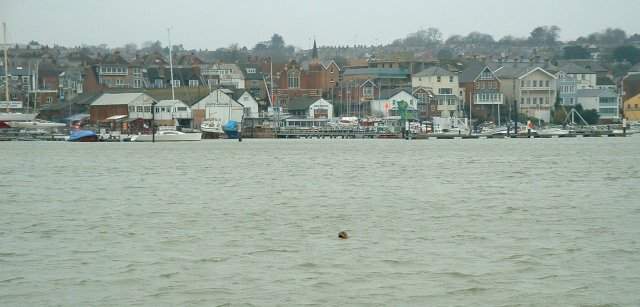
A view
of Cowes, Isle of Wight, by Luke
Richards
If
you look carefully you can spot the Common Seal seen in late
January 2002
Channel Islands
Marine
Mammals Portfolio including Grey Seals
Seal
Pup Rescue (at Brighton, Sussex)
Welsh
Seals
Grey Seals have been observed
feeding on Sewin (Sea Trout) in the River Tawe that enters the Bristol
Channel past a weir at Swansea. Report from
Dr Michael Isaac.
29
July 2001
A
Hooded Seal, Cystophora cristata, was washed on a Little Haven
beach, Pembrokeshire, south west Wales and found a home at the Seal Hospital
at Milford Haven. The seal was healthy apart from a small cut on one flipper.
The Hooded Seal is an Arctic species and even discoveries off the coast
of Scotland, including the Orkney and Shetland Isles are rare. It moults
around Greenland and the Denmark Strait (between Iceland and Greenland).
Seal Conservation Society
Hooded Seal Information
Walrus
April
1999
A Walrus,
Odobenus
rosmarus rosmarus was seen hauled out on rocks in County Mayo, Ireland
for six hours. Lying within 100 metres of the busy coastal road and spotted
as a "rock that moved", the resting walrus finally disappeared at dusk.
There have been several walrus sightings at sea off County Donegal in recent
winters, and a couple of walruses were reported to have been seen by surfers
in Killala Bay in December. A dead walrus was found in County Kerry in
January
1995.
The
Walrus is an Arctic species and is rarely seen even off Scotland and the
Shetland Isles.
Seal Conservation Society
Cornish Seals
Cornish Marine Wildlife Reports 1999 (by Ray Dennis)
Harp
Seal Report (1997)
Hooded
Seal - Cornish Report (1995)
Seal Sanctuary at Gweek, Cornwall
Orkney Seals
September
1999
A sick and exhausted six-month-old
female Hooded Seal, Cystophora cristata,
found in the Orkney Islands, Scotland, was only the third one to
have been seen in the islands. She was taken in by Orkney Seal Rescue
but unfortunately died after only a few days. For more information, contact
Ross Flett, Orkney Seal Rescue.
EMail:
selkiesave@aol.com.
Hooded Seals spend most
of their life on the Arctic pack ice.
Hooded
Seal - Cornish Report (1995)
Isle of Skye Seals
17
May 2000
A pink (leucistic)
Grey
Seal, Halichoerus grypus, was seen around the Isle of Skye,
western Scotland. As soon as the seal saw the boat, it took to the water
straight away. The other seals continued to lay around on the rocky shore.
The seal remained pink in colour even when wet, they normally turn dark.
It was clearly visible under the surface due to its light colour.
Back in July 2000 we watched a Bull Grey Seal, catch, kill and eat an adult common seal at the entrance to Lochaline. It was quite spectacular to watch but I couldn't help feel sorry for the Common Seal..
Davy
Holt, Paisley, Scotland
ICQ
81258455
Yahoo:
davyh_2001
SCOS 00/2
Scientific Advice on Matters Related to the Management of Seal Populations: 2000Under the Conservation of Seals Act 1970, the Natural Environment Research Council (NERC) has a duty to provide scientific advice to government on matters related to the management of seal populations.
NERC has appointed a Special Committee on Seals (SCOS) to formulate this advice so that it may discharge this statutory duty.
This document is available as a *.pdf electronic file, readable using Acrobat Reader, from Peter Haddow of the Seal Conservation Society. BMLSS members can request a copy from Glaucus House.
BOOK REVIEW
ISBN 1-900455-46-3
£11
The book is divided into the following chapters:
Introduction
Seals & Sea Lions
Food and Feeding
Life in the Water
The Breeding Cycle
Man, Seals & Sea Lions
Enjoying Seals & Sea
Lions
Seal & Seal Lion Facts
Index
It is worth having a close
look at this book in a bookshop and reading some of the informative text.
Page 35 is a good page to start where the explanation of the seals utilisation
of oxygen when diving is clear. There are no caption boxes with extra information
as it is all included in the main body of text. This can make it quite
a hard read as there is so much information that the reader cannot take
it in at once. There are no wasted words. Occasionally, the explanations
require a large vocabulary, which will be OK for BMLSS members but may
be too difficult for children.
Conclusion: a very
good book for the general wildlife enthusiast.
| FIVE KINGDOMS
TAXONOMIC INDEX TO BRITISH MARINE WILDLIFE
Use these links if your are familiar with the scientific classifications of marine life |
|
|
|
|
|
News 2008 |
Membership Form |
|
